Family: Anguidae (Glass Lizards and Alligator Lizards)
Genus: Ophisaurus (Glass Lizards)
|
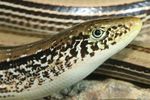
| 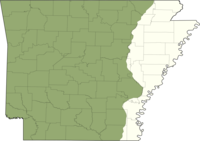
|
| Legless. Bronze-colored with dark, ⚠ lateral stripes and ⚠ lateral groove. ⚠ Middorsal stripe. External ear openings. Eyelids. Tail "as easy to break as glass".
| 
|
|
|
Family: Crotaphytidae (Collared and Leopard Lizards)
Genus: Crotaphytus (Collared Lizards)
|

| 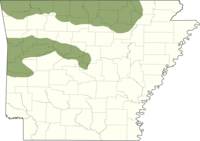
|
| Large, fast, and leery. Males more greenish with yellow chin. Females more tan. Body with white specks and faint orange-red crossbars. Two dark bars form "collar". Juveniles similar to adult females, but with more prominent, though broken, red crossbands.
| 
|
|
|
Family: Dactyloidae (Anoles)
Genus: Anolis (Anoles)
|

| 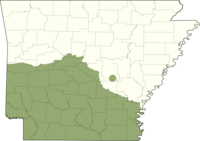
|
| Can change color from green to brown or vice versa. Light, ⚠ middorsal stripe often present. Large ⚠ dewlap for mating or territory displays.
|
|
|
|
Family: Phrynosomatidae (Spiny Lizards)
Genus: Phrynosoma (Horned Lizards) and Sceloporus (Spiny Lizards)
|
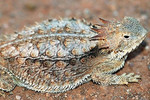
| 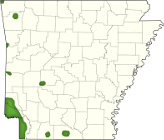
|
| Rare and likely ⚠ extirpated from AR. (Some records suspected to be released pets.) Brown-mottled with light ⚠ middorsal stripe. Built very flat with many spikes, especially on back of head. Tail very short. Cries blood as part of defense.
| 
|
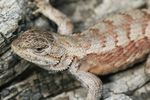
| 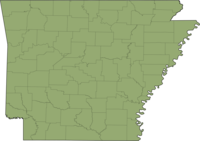
|
| Grayish-brown with faint, jagged crossbars. Scales give rough texture. Males with turquoise jowls and sides of belly during breeding season.
|
|
|
|
Family: Scincidae (Skinks)
Genera: Plestiodon (Toothy Skinks) and Scincella (Ground Skinks)
|
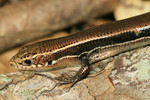
| 
|
| Bronze with broad, brown, ⚠ lateral stripe thinly bordered with white. Scales smooth and shiny. 1 postmental scale. Juveniles black with bright blue tail.
|
|

| 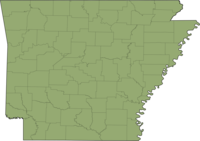
|
| Dark brown with 5 lighter stripes. Males with enlarged, reddish jaws during mating season. Scales smooth and shiny. 2 postmental scales. 7 upper ⚠ labial scales. Juveniles with more prominent contrast and bright blue tail.
|
|

| 
|
| Brown with 5 lighter stripes. Males uniform bronze and with enlarged, reddish cheeks during mating season. Scales smooth and shiny. 2 postmental scales. 9 upper ⚠ labial scales. Juveniles with more prominent contrast and bright blue tail.
|
|
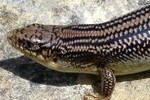
| 
|
| Rare with no vouchered specimen for AR. Body scales cream, yellowish, or tan and individually bordered with black. Scales smooth and shiny. ⚠ Lateral body scales form diagonal rows. Juveniles mostly black with bluish tail.
| 
|

| 
|
| Rare. Brownish, thinly-built many-lined skink. Dark ⚠ lateral stripe bordered above and below with light stripes. Scales smooth and shiny. Postnasal scale absent. Juveniles with bright blue tail.
| 
|

| 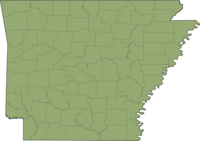
|
| Small and thin. Plain bronze with darker, more mottled sides. Belly plain and yellowish. Legs small.
|
|
|
|
Family: Teiidae (Whiptails, Racerunners, and Ameivas)
Genus: Aspidoscelis (Whiptails)
|
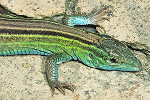
| 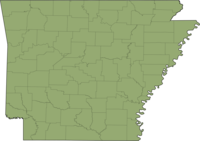
|
| Background color varies by individual (tan, yellowish, greenish, bluish, etc.), but always with 7 light stripes. Belly plain with large, rectangular scales. Juveniles with bluish tail.
|
|
|
|
~ Potential Occurrence ~
|

| 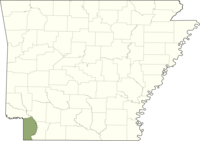
|
| Rare with no vouchered specimen in AR. Background color is brown or greenish. 7 light stripes run the length of the body. Light-colored spots occur on the sides between the lines. Belly plain with large, rectangular scales. Juveniles with bluish tail.
|
|
|
|
~ Introduced Exotics ~
|
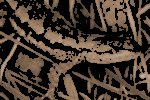
| 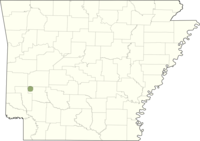
|
| Rare with no known breeding populations in AR. (A single, non-adult female voucher came from Pike County in 2002.) Brown or gray, usually with some patterning. Large ⚠ dewlap for mating or territory displays.
|
|

| 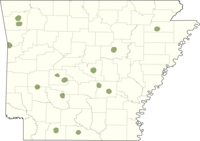
|
| Found near human habitations. ⚠ Nocturnal. Light (almost transparent) gray, brown, yellow, or pink mottled with banded tail. Skin covered in wart-like bumps. Sticky toe pads. Large eyes with vertical pupils and no eyelids.
|
|